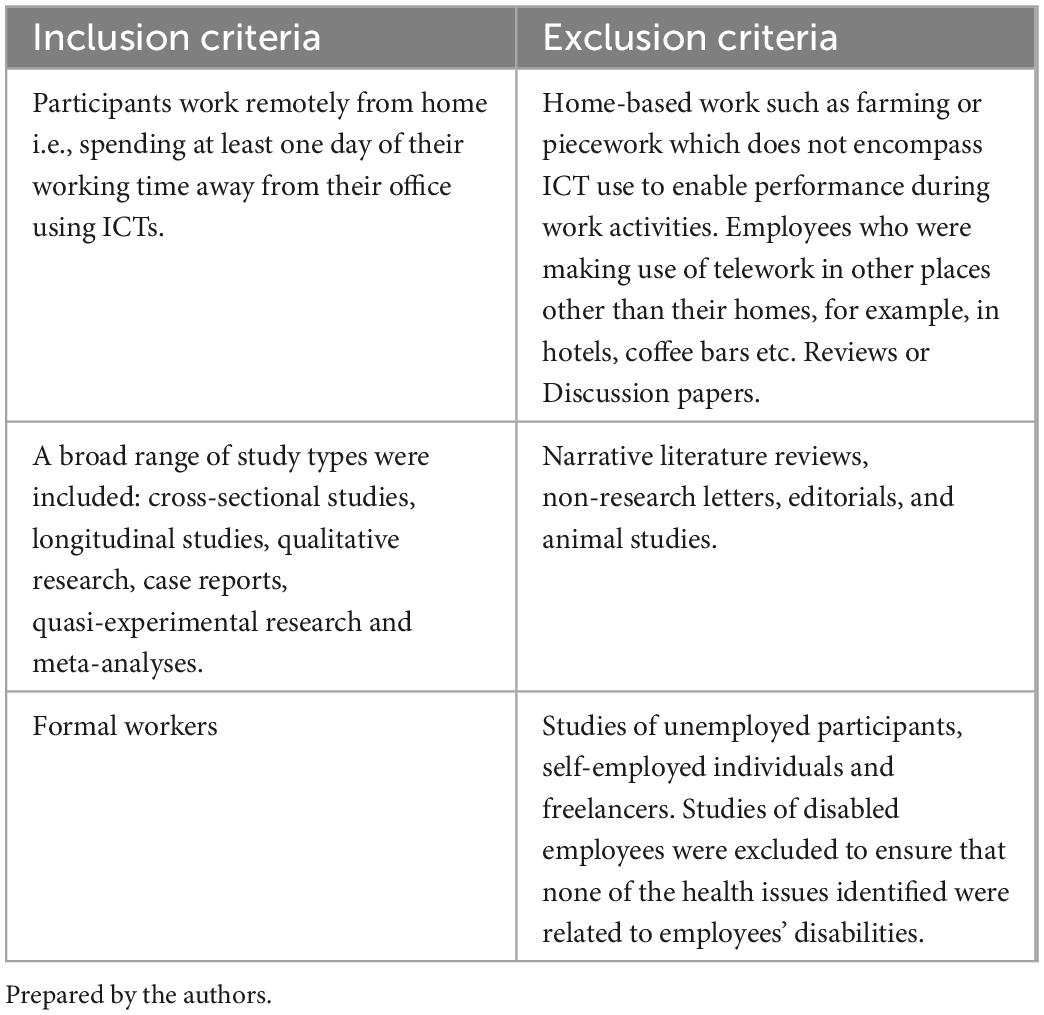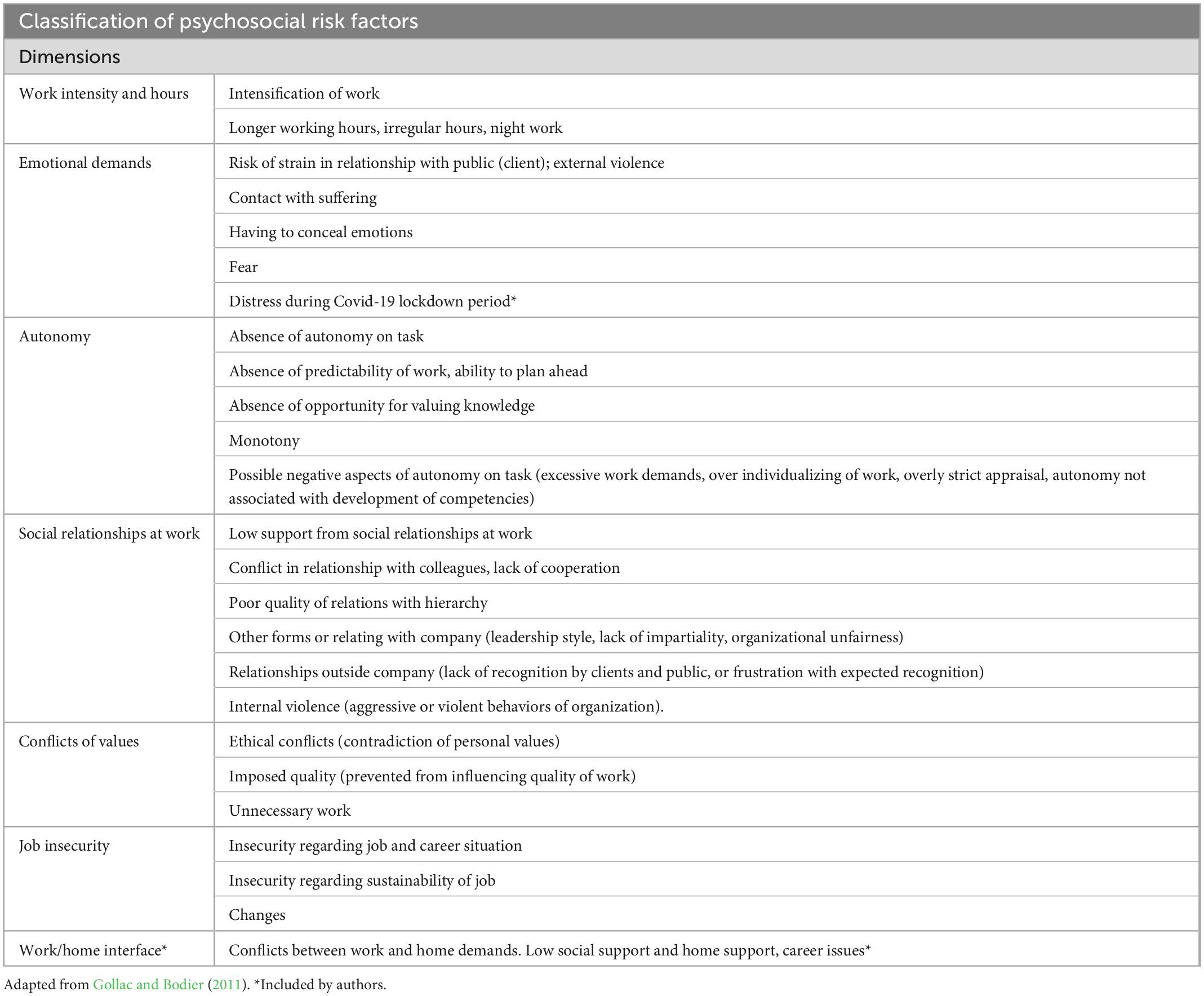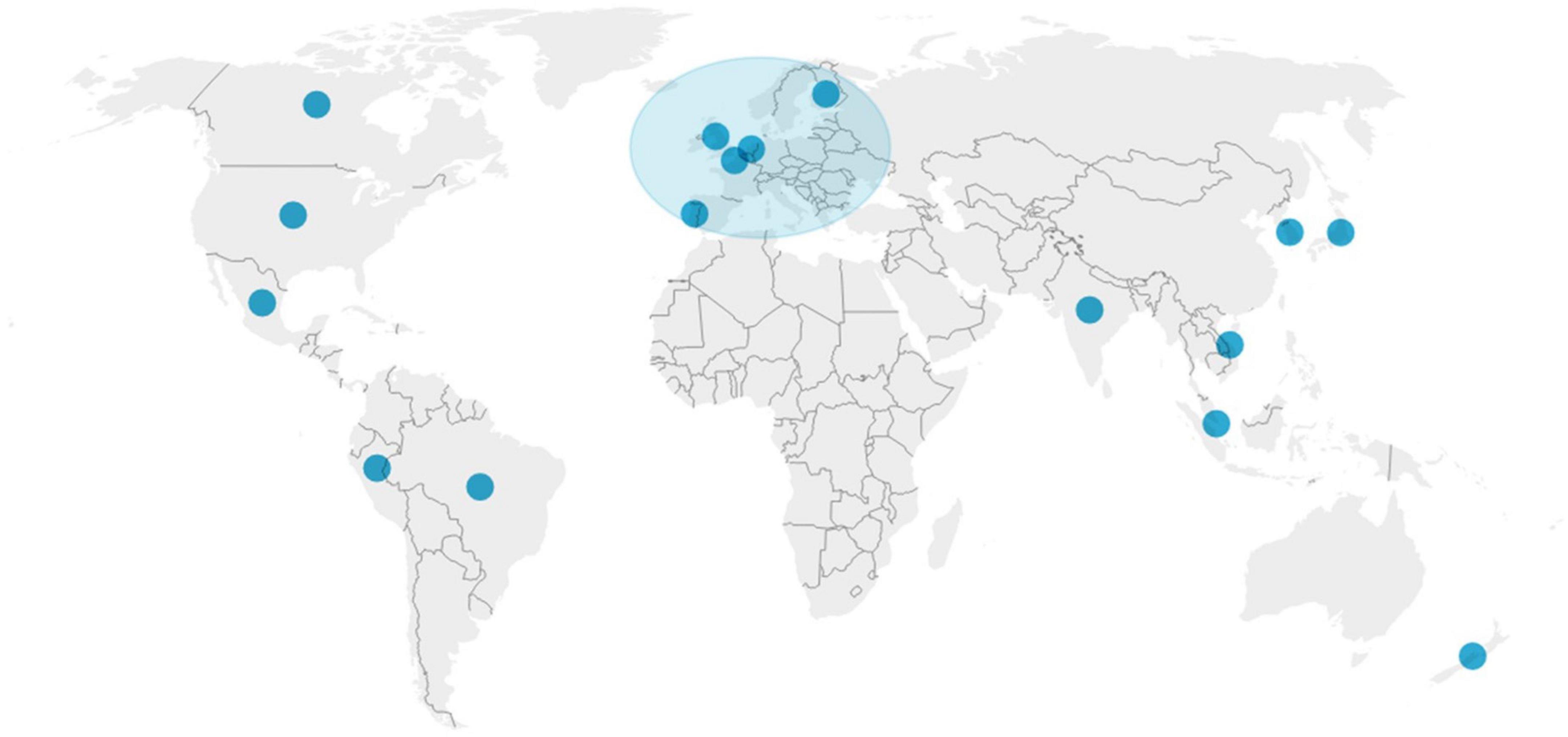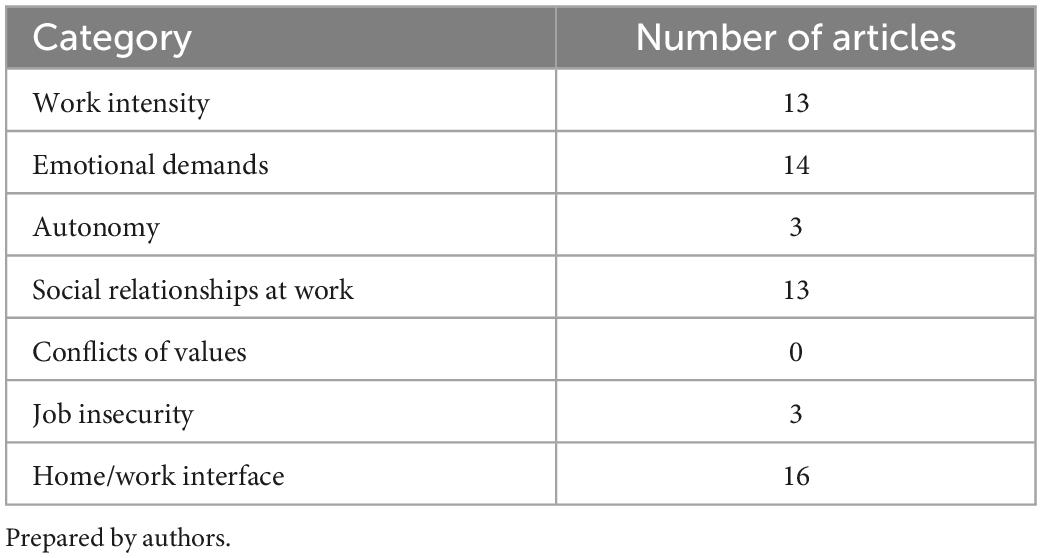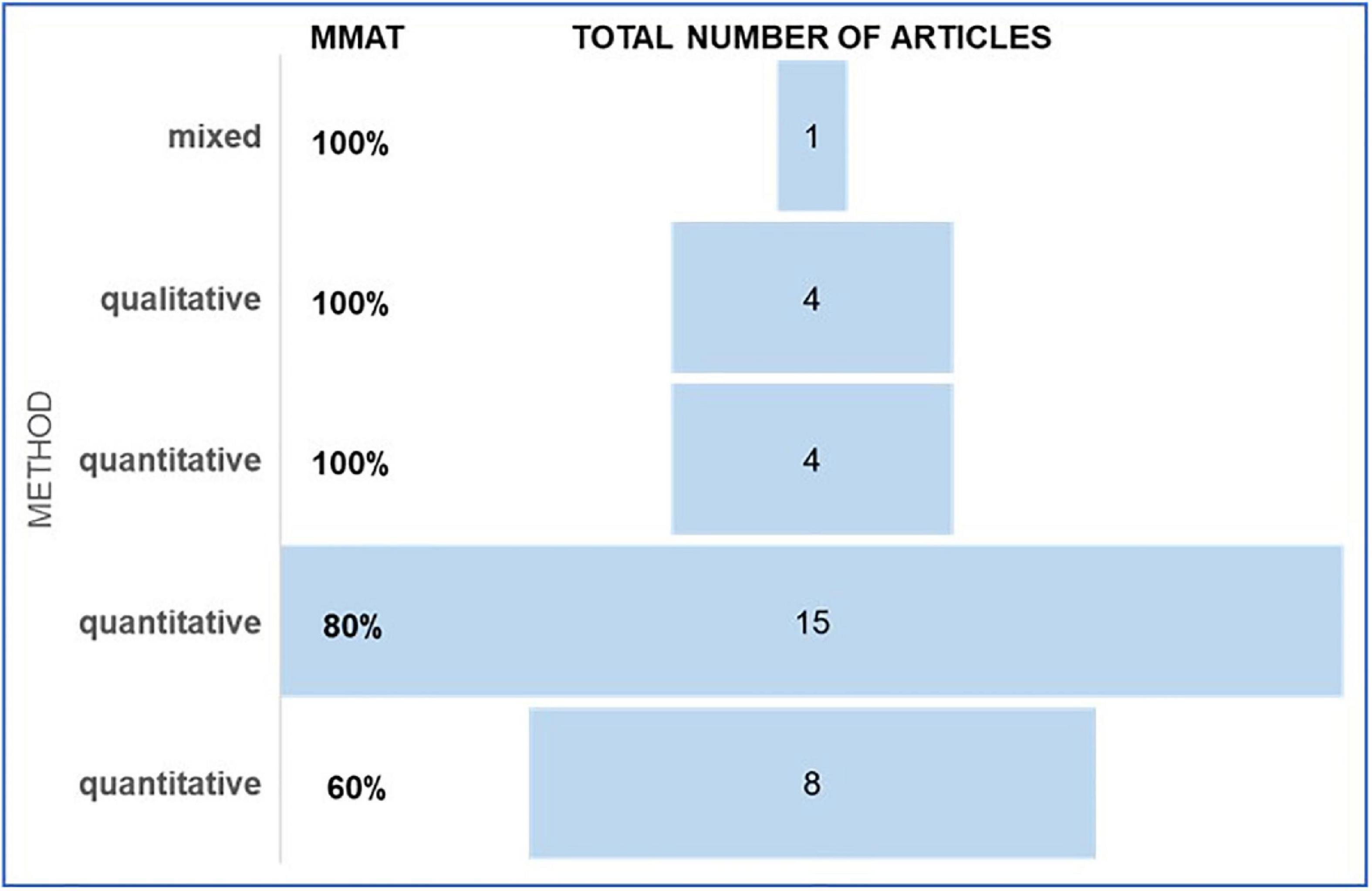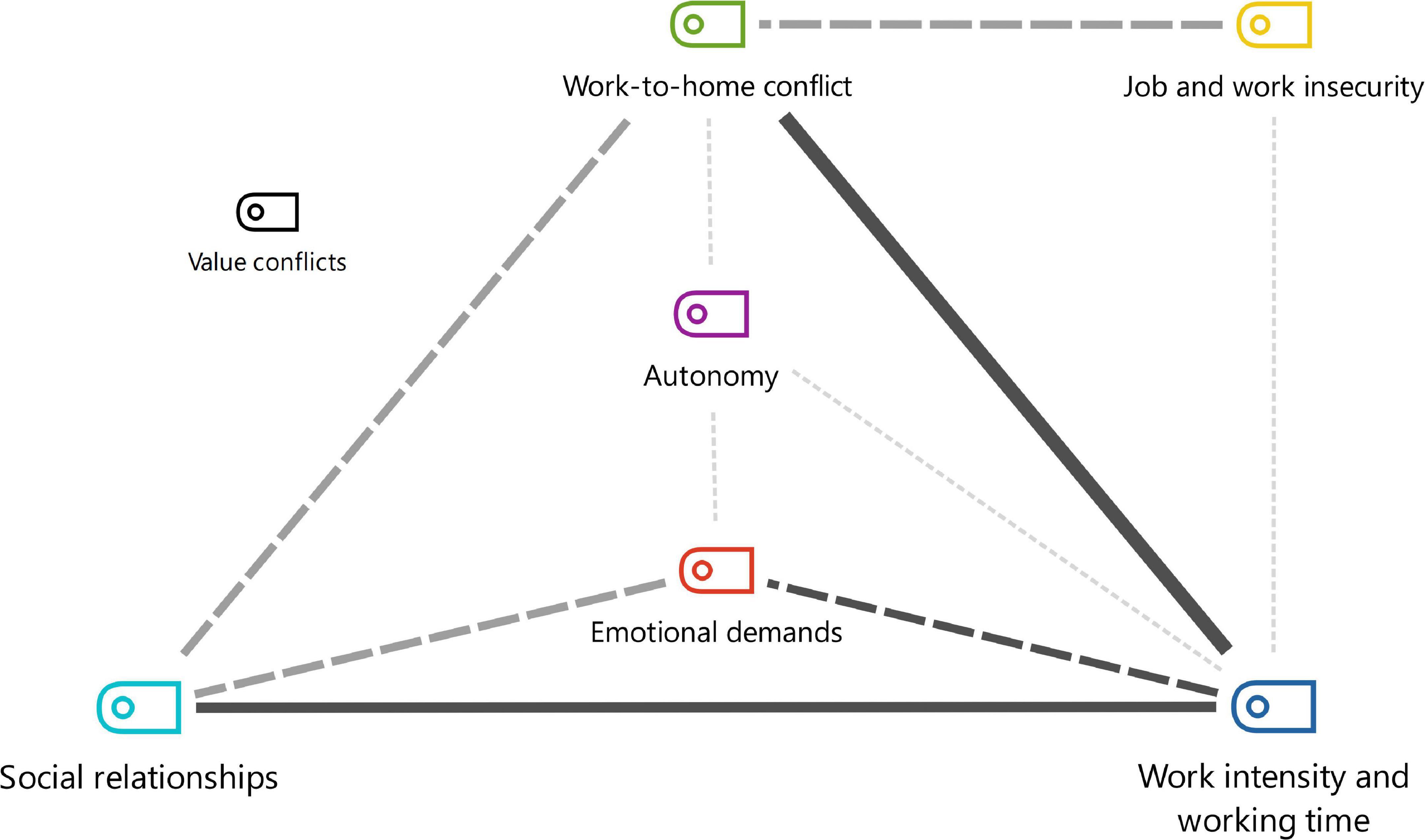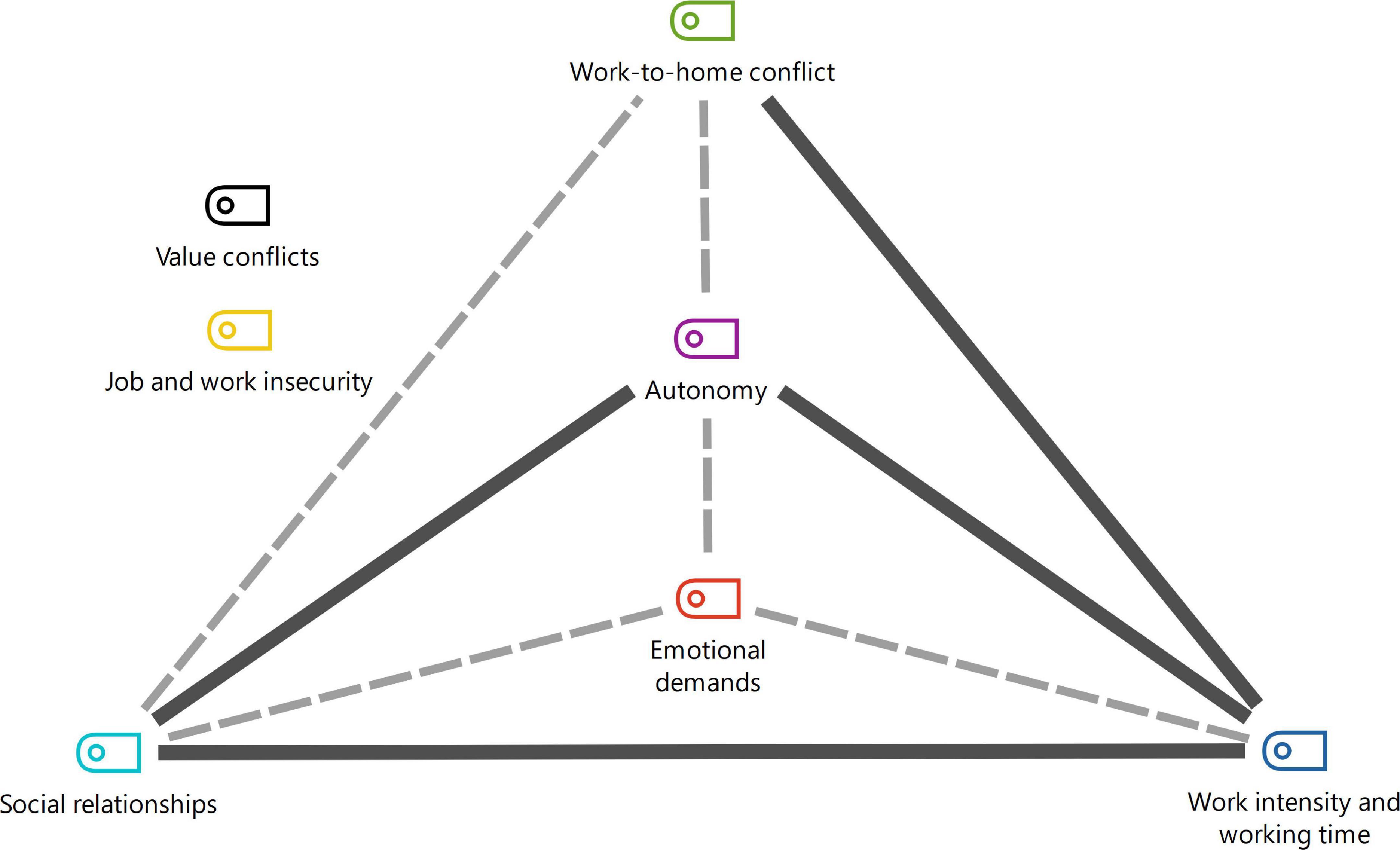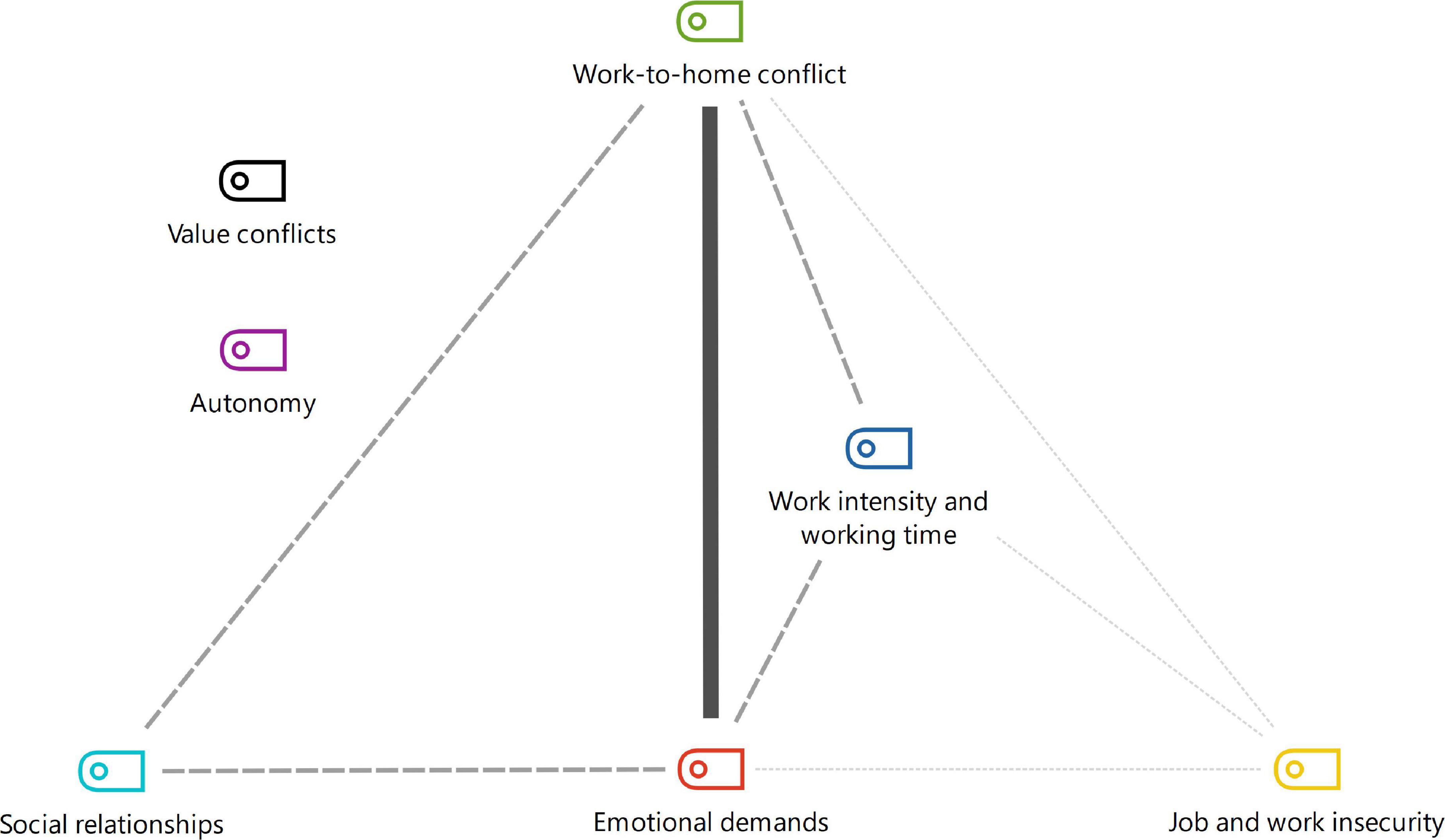- 1Federal Institute of Paraná, Curitiba, Brazil
- 2Catarinense Federal Institute, Videira, Brazil
- 3Center for Psychology at the University of Porto, Faculty of Psychology and Education Sciences of the University of Porto, Porto, Portugal
- 4Department of Environmental Health, School of Public Health, University of São Paulo, São Paulo, Brazil
Introduction: Since the start of the COVID-19 pandemic thousands of people have experienced teleworking and this practice is becoming increasingly commonplace. This review aims to highlight the differences in exposure to psychosocial risk factors for health between part-time and full-time teleworking from home.
Methods: The protocol of the systematic review of the literature was registered on PROSPERO 2020 platform according to the PRISMA statement guidelines. The key words “telework” and “frequency” (“part-time” or “full-time”), together with their synonyms and variations, were searched. Independent researchers conducted the systematic search of 7 databases: Scopus, SciELO, PePSIC; PsycInfo, PubMed, Applied Social Sciences Index and Abstracts (ASSIA) and Web of Science. Of the 638 articles identified from 2010 to June 2021, 32 were selected for data extraction. The authors evaluated the risk of bias and quality of evidence of the studies included using the Mixed Methods Appraisal Tool. Main themes categorized include 7 dimensions of psychosocial risk factors: work intensity and working hours; emotional demands; autonomy; social relationships at work; conflict of values, work insecurity and home/work interface.
Results: The results revealed scant practice of full-time teleworking prior to the pandemic. Regarding the psychosocial risk factors found, differences were evident before and during the COVID-19 pandemic. For part-time and full-time telework prior to the pandemic, the dimensions of intensification of work and working hours, social relationships at work, and the home-work interface were the most prominent factors. However, studies performed during the COVID-19 pandemic where teleworking was mostly performed full-time, there was an increase in focus on emotional demands and the home-work interface, and a reduction in the other dimensions.
Discussion: Full-time telework brings important changes in working conditions and has the potential to affect living and health conditions of teleworkers. Part-time teleworking may have positive impact on psychosocial risk factors, favoring work-home balance, communication, and social relationships.
Systematic review registration: https://www.crd.york.ac.uk/prospero/display_record.php?RecordID=191455, PROSPERO 2020 CRD4202019 1455.
1. Introduction
Teleworking is a reality for millions of employees worldwide. During the pandemic, this compulsory approach constituted a solution to minimize economic impact and maintain some activities and functions conducive to continuation using information and communication technologies (ICT). It was originally thought that teleworking would be temporary, i.e., required only until a sufficient contingent of the population had been vaccinated to allow a return to the workplace (Eurofound, 2020a; European Commission, 2020; European Agency for Safety and Health at Work, 2021). However, it has become an intelligent society strategy that, in many cases, the result was a structural change in the way of working.
Experiences differed depending on country, region, type and organization of work, residence, family composition, among other factors. For companies, there were clear benefits in terms of savings in overheads such as rent, water, electricity, telephone, internet, cleaning, maintenance, consumables, and besides reduced transport costs with commuting of workers.
For employees, benefits appear to be offset with drawbacks, with some individuals in favor but also some inquiring. Among the most well-known disadvantages are long working hours, blurring the boundaries between the organization and the employees and between home and work. These led to the consequent invasion of work into private life, social isolation, work-life conflict, and other issues that will addressed in this manuscript. Telework associated to long working hours were a phenomenon registered worldwide during the pandemic.
There is mixed opinion, with some not wishing to telework voluntarily, while others intend to continue the practice part-time or full-time. Consequently, there has been much debate over the return to face-to-face activities and continuation of teleworking. Based on the premise that differences exist between part-time and full-time teleworking, we posed the research question “what are the differences in psychosocial risk factors between part and full-time teleworking?”
Teleworking is not a new area in the literature. The precursor of studies on this modality was conducted by the North American Nilles (1975, 1979), Nilles et al. (1976, 1977, 1978), investigating the potential impact of the use of telecommunications and computer technology as an alternative to urban transportation, creating workstations at centers close to home or within them, thereby dispensing with the need to commute to work.
Nilles (1985) predicted that, within a decade, 5 million white-collar workers would be able to work from home. He identified several possible barriers to acceptance of telecommuting by workers: fear of change by workers, the new technology, personal isolation, interruption in career, threat to job security and worker exploitation. Reasons among employers were more varied: concerns of decline in productivity, increase in turnover rates, a reduced ability to adapt to changes, the legal issues and their regulation, safeguards against exploitation and the physical safety of employees working from home.
Over previous decades, despite the technology revolution and globalization, teleworking never took off in the way it has today. This modality existed before the pandemic but was available to a relatively small contingent of workers. Participation in teleworking has tripled since the start of the pandemic (Adrjan et al., 2021). For example, in the European Union, the proportion of teleworkers rose from 11 to 48% during the pandemic (Eurofound, 2020a; European Commission, 2020). In Latin America and the Caribbean, over 23 million people had transitioned to teleworking in the second quarter of 2020 (International Labour Organization [ILO], 2021a).
Following the pandemic, the full-time modality was adopted, even in job areas hitherto regarded as unfeasible, such as telemedicine. Two years on, the question is whether teleworking is set to become the “new normal.” Thus, before assuming this will be the model of working for the future, it is important to elucidate the impacts on health of those engaged in teleworking.
Unlike some technology firms which allowed its staff to telework from anywhere in the world, some large companies have decided the opposite, calling on workers to return to the office in 2022 (Colvin, 2022).
However, not so long ago, major companies such as Yahoo and Bank of America had already discontinued full-time teleworking. The technology firm Yahoo ordered home workers back to the office, detailing in a memo the shift in policy of the company’s Human Resources Department, stating that face-to-face interaction between workers promotes a more collaborative culture (Miller and Rampell, 2013).
Therefore, the present review was prompted by the fact that thousands of people have experienced teleworking since the start of the COVID-19 pandemic and given the tendency of this practice to become more commonplace. There is also an apparent acceleration of the political agenda in many countries toward regulating this work modality (Athanasiadou and Theriou, 2021). Thus, this review is a scientific contribution because it brings together studies on a topic that has gained considerable prominence recently. It can also produce helpful evidence and information to develop policies and regulations related to the differences between the psychosocial risk factors comparing part and full-time teleworking from home.
Among the previously available systematic reviews on teleworking, no differentiation was made between the place and frequency basis of teleworking, i.e., part and full-time (Charalampous et al., 2019; Macêdo et al., 2020; Athanasiadou and Theriou, 2021). The innovative part of this review is to consider the frequency dimension by associating it with workers’ perceived exposure to psychosocial risk factors and possible health impacts.
In order to provide supporting background on the topic of teleworking, the ensuing sections outline: (1) Terms, definitions and forms, organizations of telework; and (2) Psychosocial factors in teleworking and the model used as a conceptual framework for organizing and guiding the discussion of the literature.
1.1. Flexible work arrangements to teleworking
Flexible work arrangement (FWA) is a multi-dimensional concept used as an umbrella term to describe new ways of organizing work. Telework, remote work, work at home, home-based work, telecommuting, remote work from home, e-work and smart work are terms found in the literature referring to FWAs (Eurofound, 2020b). Although related and with some degree of overlap, these terms represent distinct situations. They can refer to flexible hours, such as flextime, and/or flexibility in the workplace, such as teleworking, flexiplace and e-working (Charalampous et al., 2019).
Defining these concepts to measure them has become more important than ever since the massive lockdown imposed by the pandemic. The lack of statistical standards defining conceptual differences poses a challenge, because this impacts the data, and consequently, international comparative studies (International Labour Organization [ILO], 2020).
There is currently no internationally standardized conceptual definition and ways of measuring the incidence of remote working or teleworking, although they are associated with flexibility in terms of working time and place of work (Eurofound and the International Labour Office, 2017; International Labour Organization [ILO], 2020).
Remote work can be described as situations in which the work is performed, partially or fully, at a place outside of the standard work premises (off-site). These alternative workplaces range from co-working spaces to cafes, bookshops, and client premises. In addition, workers can be independent (self-employed) or employees. However, workers of family businesses that do not have a fixed workplace, and independent workers, are typically excluded from this remote work group (International Labour Organization [ILO], 2020).
Telework is a unique category in which workers must use ICT to perform remote working (Eurofound, 2020b). It should be noted that the joint study on teleworking carried out by the ILO and Eurofound was restricted to employees only (Eurofound and the International Labour Office, 2017).
Home-based workers constitute those for whom their main place of work is their home, representing a subcategory of work at home. Working predominantly from home differs to working out of different places (public spaces, co-working, and client premises), and akin to frequency, the use of workspaces are aspects which, according to intensity, may have different consequences for working conditions (Eurofound and the International Labour Office, 2017).
In the present review, the term part-time telework from home is used to refer to home teleworking performed by workers that work from home for just 1 or 2 days a week for example. By contrast, the term full-time telework from home refers to weekly teleworking from home, with occasional visits to the office. Given that teleworking may be full or part-time, it is important to explore differences between work arrangements, the impact on the work-life balance, working hours, productivity, health, and well-being (International Labour Organization [ILO], 2021b). It follows that the intensity of teleworking should also be considered in field research, as opposed to merely comparing teleworkers versus non-teleworkers (Bailey and Kurland, 2002; Gajendran and Harrison, 2007; Dancaster and Baird, 2016; Hoornweg et al., 2016).
1.2. Conceptual framework
This section presents the conceptual framework underpinning the discussion, outlining the concepts and dimensions of the psychosocial risk factors covered by the study. The COVID-19 pandemic was accompanied by an increase in the inequalities that already existed in teleworking and an exacerbation of the risks associated with the practice (Dierickx, 2021). Given the importance of teleworking during 2020 and 2021, and its continuity in many companies despite the significant decline in the number of COVID-19 cases, attention has turned to the psychosocial factors associated with teleworking.
As is the case of teleworking, psychosocial risk factors for health in the workplace are not a new phenomenon. International Labour Organization [ILO] (1984) published the first official document with this issue on its agenda, alerting to the growing incidence and need for intervention and programs to protect workers’ health. In the document, psychosocial factors at work were defined as “interactions between and among work environment, job content, organizational conditions and workers’ capacities, needs, culture, personal extra-job considerations that may, through perceptions and experience, influence health, work performance and job satisfaction” (International Labour Organization [ILO], 1984, p. 3).
Since then, decades of studies have been carried out on this area, yet with no consensus on interpretation under different conceptual models (Costa and Santos, 2015; Rodrigues et al., 2020). Therefore, the conceptual framework of Gollac and Bodier (2011) was adopted for this study, given that it was derived from a report produced by a panel of experts set up upon request of the French minister for work, tasked with monitoring psychosocial risks at work.
According to Gollac and Bodier (2011), psychosocial factors are “risks to mental, physical and social health caused by working conditions and by organizational and relational factors subject to interaction with mental functioning” (p. 13). These authors grouped the factors into 6 dimensions:
(1) Intensity of work and working hours; (2) Emotional demands; (3) Autonomy; (4) Social relationships at work; (5) Conflicts of values; and (6) Job insecurity.
This classification seeks to understand how the different dimensions of work influence and/or determine the process of illness. This framework was used to group and discuss markers of psychosocial risk from the European Working Conditions Survey (EWCS), employed to monitor the countries of the European Union (Eurofound, 2012).
For the first dimension addressing intensity of work and working hours, the immediate consequences/determinants of intensity and complexity of work must be examined, along with the duration and organization of work time (Gollac and Bodier, 2011). Emotional demands, on the other hand, linked with relationships with the public and can be particularly high for those who work with suffering or pain; these can be positive, but may also cause distress (Costa and Santos, 2013). Autonomy denotes the possibility of the worker having control over their work through involvement with the output. The risk related to this aspect lies in a lack of autonomy (Gollac and Bodier, 2011). The fourth dimension–social relations at work–consists of the social relationships between workers, and the relationship between worker and the employer. This aspect includes a number of variables, such as opportunities for cooperation; satisfactory support in difficult situations; situation of strain, excessive competition; collective autonomy; participation; technical support received from superiors; human relationships; leadership and style of facilitation; valuing of work; remuneration and career; suitability of the task for the individual; work appraisal; procedural fairness; care regarding wellbeing of workers; recognition by clients and the public; social value of the job; effects of violence; forms of internal violence; and violence at work (Gollac and Bodier, 2011). Conflict of values refers to ethical suffering when an individual is asked to act in breach of their professional, social, or personal values (Gollac and Bodier, 2011). The sixth and last dimension–job insecurity–includes the socioeconomic insecurity risk of uncontrolled change in the work task and conditions. Socioeconomic insecurity encompasses, for workers, the chance of losing one’s job, insecurity over maintaining salary levels or lack of the usual trajectory of career advancement for the job (Gollac and Bodier, 2011).
2. Materials and methods
Based on methodological standards, a systematic review protocol was devised and registered on the PROSPERO platform–International Prospective Register of Systematic Reviews (PROSPERO 2020 CRD42020191455) in June 2020. The protocol followed the Preferred Reporting Items for Systematic Reviews and Meta-Analyses for Protocols 2015 (PRISMA-P 2015) (Moher et al., 2015).
The process of constructing the guiding question defining descriptors and search mechanisms began based on the PICO strategy. Regarding the meaning of the PICO acronym: (P) refers to the target Population, (I) denotes the aim of the Intervention or area of interest, (C) cover types of intervention or groups for Comparison, and (O) addresses obtaining Outcomes and involves the effects to be achieved by the intervention (author) (Moher et al., 2015), in this case: “What are the differences in the psychosocial effects of part-time and full-time teleworking?”
2.1. Search strategy
The present search strategy was applied similarly to all databases and consisted of one block of keywords intended to cover the various denominations used for “telework” and frequency (“part-time” or “full-time”) as well as its synonyms and variations:
“telework*” OR “telecommute*” OR “remote work*” OR “work* from home” OR “distributed work*” OR “flexible work*” OR “homework*” OR “virtual work*” OR “virtual office” OR “mobile *work*” OR “e-work” OR “teletrabalho*” OR “trabalho à distância” OR “trabalho de casa” OR “trabalho distribuído” OR “trabalho flexível” OR “trabalho no domicílio” OR “trabalho virtual” OR “escritório virtual” OR “trabalho móvel” OR “teletrabajo*” OR “trabajo a distancia*” OR “trabajo desde casa” OR “trabajo distribuido” OR “trabajo flexible*” OR “trabajo en casa” O “trabajo virtual*” O “oficina virtual” OR “trabajo móvil*.”
Based on the search protocol established, two independent researchers conducted a systematic search of 7 electronic databases: Scopus, SciELO, PePSIC; PsycINFO, PubMed, Applied Social Sciences Index and Abstracts (ASSIA), and Web of Science. All searches were limited to articles in relevant psychological, social, management, health and technological scientific journals published from 2010 to June 2021. Peer-reviewed, full publications, written in English, Spanish, or Portuguese were eligible. Unpublished studies were not retrieved. Additionally, the search strategies of relevant systematic reviews were reviewed.
2.2. Study participants/population and types
Participants were part-time or full-time teleworking employees, aged 18 years or older. Teleworking was defined as the use of ICTs, such as smartphones, tablets, laptops, and desktop computers, for the purposes of working from home. The term part-time teleworking was used to refer to regular telework performed by employees working from home, for example, only 1 or 2 days a week.
Original, quantitative, qualitative, and mixed methods studies were included in the search according to the inclusion and exclusion criteria shown in Table 1.
2.3. Data extraction (selection and coding) and synthesis
Two researchers, blinded to each other’s decisions, independently extracted data from all studies. Titles and abstracts, retrieved using the search strategy, were screened for eligibility to identify studies that met the inclusion criteria. Discrepancies were resolved and three researchers came to an agreement on data to be included in the extraction process. Data extraction included Ref ID; First author; year; citation; study aims; sample population; country where study was undertaken; type of study; characteristics of telework; psychosocial effects measured, and main findings. Mendeley software was used to manage the references. Data were stored in an Excel spreadsheet.
The authors evaluated the risk of bias and quality of evidence of the studies included using the Mixed Methods Appraisal Tool (MMAT) Version 2018 (Hong et al., 2018). This is a 5-item checklist that yields a score ranging from 0 (no criteria met) to 5 (all criteria met) and can be used across a range of different study designs, such as randomized controlled trials and observational studies. Two authors independently assessed the study quality of the studies included and discrepancies were resolved afterward. The heterogeneity of the studies included in this review precluded a statistical summary or meta-analysis. A narrative synthesis (Snilstveit et al., 2012) was produced from the studies included, centering on the differences between the psychosocial effects of part and full-time teleworking.
During the process of reading and extraction, and rechecking of identified and unidentified categories was carried out. The contents present in the articles were assessed and compared across categories related to psychosocial risk factors as per Gollac and Bodier (2011) (Table 2). This activity allowed the references to be built which supported the discussion.
In view of the shift in context during the COVID-19 pandemic and challenges regarding analysis of work, about teleworking, the authors broadened the classification of Gollac and Bodier (2011) by including the additional (category, 7) Home/work interface (to gauge difficulties involving this interface), plus a subcategory associated with emotional demands (category 2), distress during the COVID-19 lockdown period.
Lastly, after classification and analysis of the dimensions, a co-occurrence analysis was performed. Connections and interrelations between the articles and categories under discussion were explored. This comparison was achieved with a map of coded authors and classifications using the MAXQDA Plus 2022 software tool (Kuckartz and Rädiker, 2019).
3. Results
During the analysis of the results based on the key words presented in the methods section, the highest number of publications on teleworking was conducted in the United States. However, the wide range of articles found provides a representative view of the subject at least in the Americas, parts of Europe and in some countries of Asia (Figure 1).
According to the PRISMA statement (Moher et al., 2015), an initial selection was made based on titles and abstracts in order to exclude unavailable sources or publications which failed to meet the screening criteria adopted during the search strategy. Duplicate records due to the multiple databases searched were also removed. Full texts of the selected abstracts were revisited for a more in-depth review. The flow diagram of the PRISMA process summarizing the study selection process is depicted in Figure 2. Data collection took place in two stages, in September 2020 and a later update of more recent articles in June 2021.
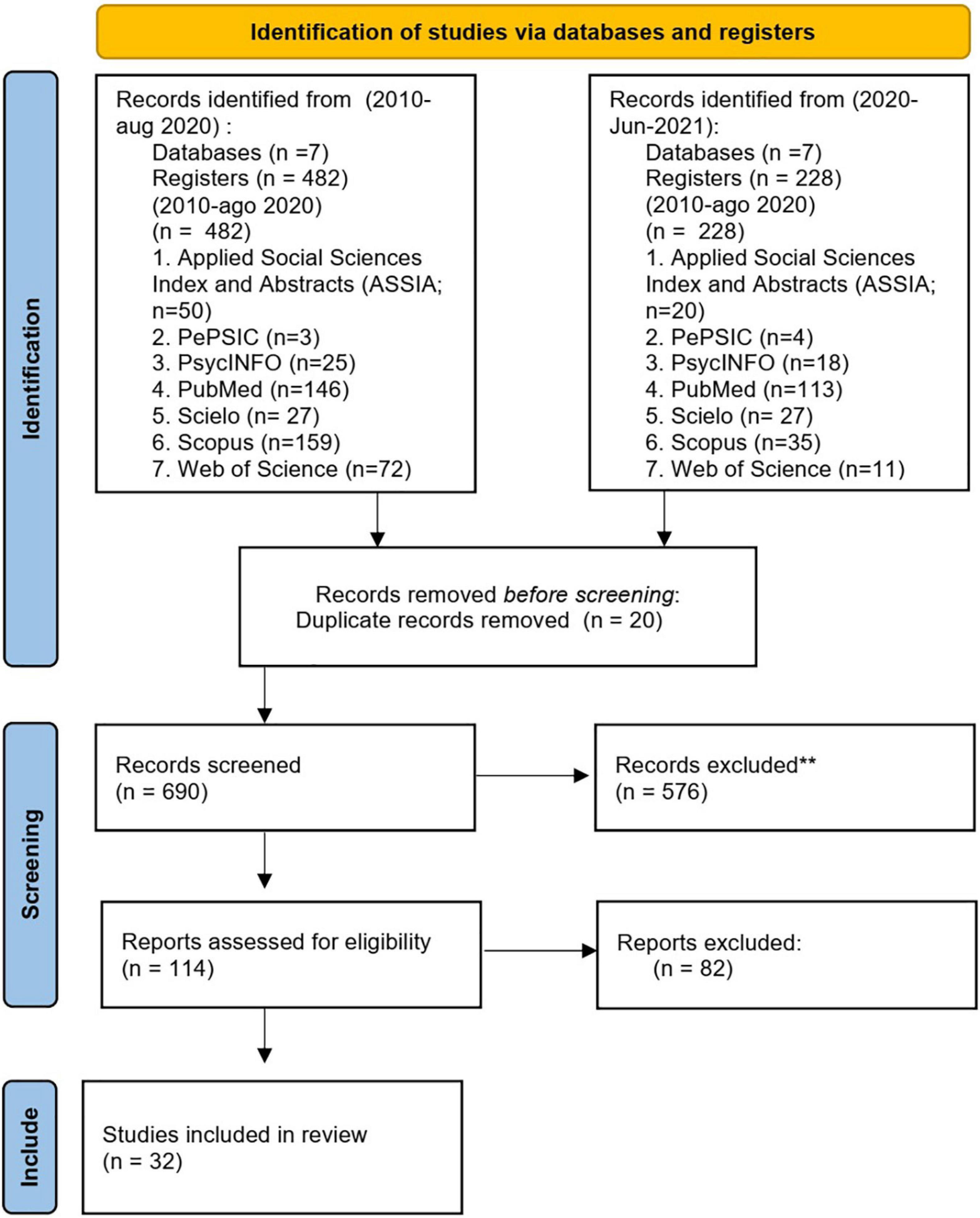
Figure 2. PRISMA flow diagram. Adapted from Moher et al. (2009).
Of the initial 638 studies retrieved, 114 studies were eligible. A total of 82 articles were excluded at the full-text screening stage because they did not investigate teleworking from home (16 studies), focusing instead on flexible working practices or flextime work arrangements (48 studies), or the article content was not related to psychosocial factors (6 studies), or study had a different type of design to that required (e.g., comments, reviews, published in non-science journals, or were editorials) and other criteria (12 studies).
Of the total articles selected, 21 were on part-time teleworking, 11 of which also addressed full-time teleworking, and 8 articles focused solely on full-time teleworking. A synthesis of all full articles was performed, providing positive and negative findings on interactions between work conditions and environment, organizational conditions, social conditions, job content and functions, efforts, besides individual and family characteristics of teleworkers. Following reading and analyses of the articles, these were classified into 7 categories (Table 3).
The analysis found that 18 articles addressed more than one category, with 8 addressing 2 categories, 8 investigating 3 categories and 2 involving 4 categories. A total of 14 articles explored one category only. However, none of the articles studied the 5th category of “conflict of values.”
The results from the MMAT are depicted in Figure 3. The qualitative synthesis of the articles reviewed, along with the main results for each publication including positive and negative aspects of teleworking, is presented in Table 4.
4. Discussion
4.1. Dimensions of psychosocial risk factors
The evidence on psychosocial risk factors at work is heterogeneous, given these are related to work organization and different variables. Therefore, the present study sought to shed light on the issue by identifying the amplified (most found) and reduced (least found) dimensions comparatively in the published articles, for part-time and full-time home-based teleworking (Table 5).
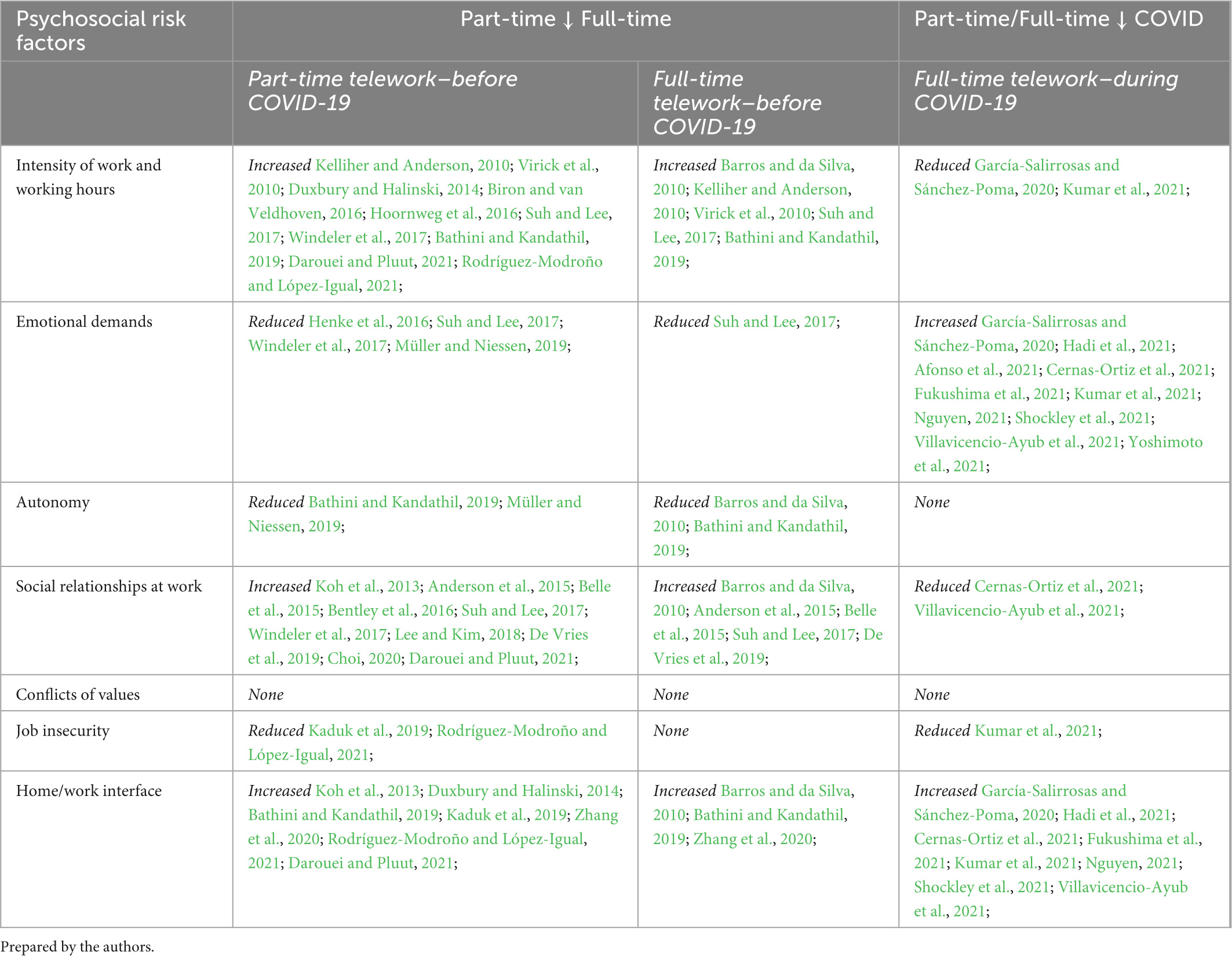
Table 5. Analysis of results by authors related to the dimensions of the psychosocial risk factors found.
4.1.1. Work intensity and working hours
Telework is generally associated with intensification of work (Kumar and Velmurugan, 2018; Bathini and Kandathil, 2019; European Agency for Safety and Health at Work, 2021; Villavicencio-Ayub et al., 2021). Bathini and Kandathil (2019) found that, in certain settings, managers use telework as a strategy to reduce reluctance of workers to undertake an intensified work schedule. Intensification of work is not a reciprocal exchange between employee and employer. Telework can also be a facilitator of longer working days, making it easier for the employer to demand work hours that exceed limits stipulated by law (Bathini and Kandathil, 2019). In exchange for greater autonomy, companies also raise the level of pressure: somebody from the company sends an email and expects a rapid response, obliging the individual to reorganize their priorities, exceeding working times and expecting more from the employee (Barros and da Silva, 2010).
The phenomenon of “unimposed” intensification is highlighted by Kelliher and Anderson (2010), in which may remote workers showed that when homeworking, the working day tended to be longer, with more intense effort made. The only study conducted prior to the pandemic involving solely full-time teleworkers outlined the difficulties establishing limits for time dedicated to work (Barros and da Silva, 2010).
On the other hand, authors showed that home-based teleworking can be associated with more positive emotional results (Fonseca and Pérez-Nebra, 2012; Biron and van Veldhoven, 2016; Darouei and Pluut, 2021). Flexible hours are also an aspect perceived as positive by individuals (Barros and da Silva, 2010). However, when the working hours are controlled by the company, these positive results may not persist (Biron and van Veldhoven, 2016).
Intensification of work can be associated with autonomy. According to Duxbury and Halinski (2014), the control over work demands afforded by telework becomes more important as working hours per week rise.
Studies carried out during the pandemic confirm intensification of home-based full-time teleworking, both through longer work hours in front of the computer during the day, and working weekends, sometimes under pressure from superiors (García-Salirrosas and Sánchez-Poma, 2020; Kumar et al., 2021). In Europe a higher proportion of workers working from home (35%) during the pandemic worked long hours: between 41 and 60 h per week compared to employees working solely on their employer’s premises (19%) (Predotova and Vargas Llave, 2021).
Long working hours can be associated with pressure for productivity from management. On the other hand, the role of leaders can favor the productivity attained at home, which can be both higher and more enjoyable (Villavicencio-Ayub et al., 2021). However, the same authors showed that the lack of regulations governing homeworking precludes the establishment of a work-life balance, clashing with productivity and working hours (Villavicencio-Ayub et al., 2021).
Productivity can be viewed as a paradox in that its increase can be related to the higher number of hours worked beyond the normal working week owing to the lack of regulation or control of times worked. Hoornweg et al. (2016) examined the productivity-teleworking relationship, concluding that the higher (>8 h per week) the telework intensity, the lower the individual productivity.
Work intensity and working hours are associated with job complexity in its quantitative and qualitative dimensions (Gollac and Bodier, 2011). This has drawn the attention of international organs with respect to health and safety at work, working hours, life-work balance, occupational health, and safety risk prevention in teleworking (European Agency for Safety and Health at Work, 2021). Part of this advance in the discussions, regulations and implementation includes the “right to disconnect” (European Agency for Safety and Health at Work, 2021).
4.1.2. Emotional demands
This dimension was not prominent prior to the COVID-19 pandemic. Barros and da Silva (2010) found that pressure to deliver was often self-imposed, driven by the feeling that responsibility for results rests with the individual. These findings are congruent with the study by Müller and Niessen (2019), in which employees reported higher use of self-reward, self-goal setting, and visualization of successful performance on home days. These results may be explained by the social and professional isolation promoted by teleworking, the worker centrality, individual performance, and loss of group working/learning.
Suh and Lee (2017) reported feelings of invasion of privacy among teleworkers due to the presence of technology. Windeler et al. (2017) found that external interaction (interpersonal) increased work exhaustion for part-time teleworkers.
The intensification of emotional demands during the COVID-19 period impacted job performance (Hadi et al., 2021; Kumar et al., 2021; Villavicencio-Ayub et al., 2021). Effects such as social isolation, high exposure to electronics use and fear can form a backdrop for risk factors and impact on the mental and physical health of workers, such as emotional exhaustion, symptoms of anxiety and depression and augmented pain (García-Salirrosas and Sánchez-Poma, 2020; Afonso et al., 2021; Fukushima et al., 2021; Hadi et al., 2021; Yoshimoto et al., 2021). Fear of COVID-19 was associated with those who most liked to adhere to home-based teleworking (Nguyen, 2021).
Gender issues were hitherto little explored in studies on teleworking. Some findings are conflicting, such as those of Afonso et al. (2021) showing that men reported lower rates of productivity than women in teleworking vs. Shockley et al. (2021) who found that productivity was affected in both men and women with children during the pandemic.
Married professionals had higher workload due to COVID-19 and high risk of distress (Kumar et al., 2021). The relationship of family distractions, lifestyle choice, role overload and operational discomfort with life satisfaction, respectively, was sequential and positively mediated by distress and job performance (Kumar et al., 2021). Negative effects of work-family conflict also affect job satisfaction and self-reported productivity, according to Becerra-Astudillo et al. (2022).
4.1.3. Autonomy
This is defined as the possibility of the workers being active as opposed to passive regarding their job, participation in production and leading their professional lives (Gollac and Bodier, 2011).
This aspect was addressed in two pre-COVID studies, where Bathini and Kandathil (2019) noted that control of time autonomy was a dominant paradox, in as far as workers who enjoyed job autonomy through use of flexible work arrangements ultimately worked more and for longer.
Müller and Niessen (2019) examined the mediating role of autonomy in part-time teleworkers. Autonomy plays a mediating role in the association between working location and self-reward, self-goal setting, visualization of successful performance and evaluation of beliefs, and assumptions (Müller and Niessen, 2019).
A group of researchers that analyzed psychosocial risks of work recommended that further studies (special review of literature review, specific epidemiological studies, and qualitative studies) be conducted to examine the effects of worker autonomy when the intensity of other psychosocial risk factors are very high (Gollac and Bodier, 2011). It was clear that, when telework was mostly voluntary during the pre-COVID era, autonomy was a pre-requisite. However, given the compulsory nature of telework during the pandemic, further investigations into this dimension were called for.
4.1.4. Social relationships at work
Unlike emotional demands, the dimension of social relationships at work was more explored in pre-pandemic studies. Social and professional isolation is one of the most reported disadvantages in teleworking–a model that individualizes life at work. Particularly, for mental health, and collective action to confront the guarantee of rights, this is a key critical point.
This aspect is associated with difficulties involving communication (synchronism), integration and lower visibility (Barros and da Silva, 2010; De Vries et al., 2019). However, this problem increases in employees engaged in higher intensity teleworking who work remotely for long periods, reducing job satisfaction and increasing psychological strain (Bentley et al., 2016).
Working entirely from home led to the public servants studied by De Vries et al. (2019) experiencing lower organizational commitment, an effect not seen on days worked partially from home. According to Belle et al. (2015), not belonging among high-intensity teleworkers might be associated with a lack of credibility, conflict, a loss of stability and feeling of invisibility.
However, it is also important to observe the relationship between teleworkers and non-teleworkers. The findings of Suh and Lee (2017) showed that task interdependence increased overload in the low-intensity teleworking group but did not have a significant effect in the high-intensity telework group. In the study by Windeler et al. (2017), interdependence increased work exhaustion for both teleworkers and non-teleworkers.
The findings of studies published during the pandemic echoed those of previous studies in which social support mechanisms, in and outside the workplace, are relevant for teleworker satisfaction (Cernas-Ortiz et al., 2021). Leadership, organizational support, and education are also fundamental aspects for satisfactory job performance (Villavicencio-Ayub et al., 2021). The fact workers of the companies were in the same situation may have promoted greater affect via social support during remote working between workers and supervisors. Similar results were mentioned by Becerra-Astudillo et al. (2022), (p. 1). These authors observed that “communication with coworkers, time spent teleworking and workplace suitability positively affect self-reported productivity while trust on the part of the supervisors positively affect job satisfaction.”
4.1.5. Conflicts of values
No evidence characterizing psychosocial risk factors related to conflict of values was found in this systematic review of the literature. Gollac and Bodier (2011) showed that conflict of values rarely features in surveys on working conditions and on the nature of psychosocial risk factors. Conflicts of values can take on the form of an ethical conflict, when the worker is asked to act in breach of his/her professional, social, or personal values, and in other ways, such as being prevented from carrying out work of quality and the feeling of doing useless work through the tradeoff between quality and quantity (Gollac and Bodier, 2011).
The lack of relevant studies on this dimension in this systematic review does not imply the factor is non-existent. A recent study published in 2022 offered clues in an excerpt from a worker’s narrative that pointed to the need for studies that address this category:
Now, there is a feeling and concern on the surface that the field cannot be done very well and continuous development exhausts work communities. This brings me as a developer an ethical conflict and in a way eats away the motivation to do development work. I wonder how the development of work in everyday life a more natural part of the whole structure could be, neither detached, nor temporary, nor a necessary evil imposed by the employer that tears at many different goals and objectives. [Syvänen and Loppela (2022), p. 9, bolding by authors of present review].
4.1.6. Job insecurity
In the United States of America (USA), full-time employees had a high level of commitment (Choi, 2020). However, also in the USA, workers engaged in substantial involuntary remote working reported greater job insecurity than others (Kaduk et al., 2019).
Moreover, telework can reinforce traditional gender roles (Rodríguez-Modroño and López-Igual, 2021). An analysis of the 28 countries of the European Union showed that women teleworking from home, besides receiving a 31% lower salary than men, also had greater perceived insecurity at work than men (Rodríguez-Modroño and López-Igual, 2021).
Amid the different governmental measures for tackling the pandemic, aspects of job insecurity were heightened. This manifested in the form of intensification of work to avoid job loss and accepting lower salaries (Kumar et al., 2021; Villavicencio-Ayub et al., 2021).
4.1.7. Home/work interface
The family appears to act both as a source of distraction and guide for priorities (Barros and da Silva, 2010). The family does not always recognize that boundaries must be drawn separating work and home life, given it is easily presumed the individual is available at any time, in addition to issues of sharing spaces (Barros and da Silva, 2010; Bathini and Kandathil, 2019). Work-to family conflict can affect levels of commitment and affective states such as emotional exhaustion, job engagement, and negative affects toward the organization (Darouei and Pluut, 2021).
Zhang et al. (2020) suggested that, as one of the most important characteristics in the family sphere, children play a key role in telework. The presence of children not only increased work-to-family conflict but also triggered redivision of housework within couples and aggravated gender differences (Duxbury and Halinski, 2014; Zhang et al., 2020).
For women, the need to reconcile is greater, because involvement in childcare tends to be higher (Barros and da Silva, 2010). They also reported more work-to-family conflict, stress, and anguish, but did not differ from men in terms of job satisfaction work, intention to leave or burnout (Kaduk et al., 2019). According to Rodríguez-Modroño and López-Igual (2021), full-time home-based teleworkers, both men and women, had better conciliation between work and family and social commitments, whereas occasional teleworkers had worse professional balance.
During the pandemic, it was found that interpersonal relationships within the home were disrupted by confinement, leading to conflicts in personal and family life (Villavicencio-Ayub et al., 2021). From a personal perspective, positive relationships were found between daily job and home demands, but unfavorable relationships with emotional exhaustion developed during teleworking (Hadi et al., 2021). Greater family distractions and role overload increased distress and negatively impacted job performance (Kumar et al., 2021).
Corroborating pre-pandemic studies, childcare fell mostly to wives. Husbands helped occasionally, for example, 1 day a week or during a wife’s important meeting (Shockley et al., 2021).
4.2. Inter-relationship between dimensions of psychosocial risk factors
Psychosocial risk factors at work stem from interaction of a social situation (organization, status, economic conditions, and work conditions) with mental functioning (Gollac and Bodier, 2011).
Co-occurrence analysis, i.e., frequency with which dimensions appear together in the same study, resulted in the different intersections depicted in Figures 4–6. The dimensions exhibited strong, medium or low connection with each other, according to the frequency of telework practiced.
Regarding co-occurrence of the dimensions of part-time teleworking before the pandemic, a strong connection was identified for work intensity and working time with social relationships and work-to-home conflict (Koh et al., 2013; Duxbury and Halinski, 2014; Suh and Lee, 2017; Windeler et al., 2017; Bathini and Kandathil, 2019; Darouei and Pluut, 2021; Rodríguez-Modroño and López-Igual, 2021; Figure 4). The results cited corroborate the fact that the dimensions studied do not manifest individually.
Results also revealed that the strong relationships of part-time teleworking persisted for full-time teleworking before the pandemic, on top of the strong association of the autonomy dimension (Barros and da Silva, 2010; Suh and Lee, 2017; Bathini and Kandathil, 2019; Figure 5). These results suggest that, before the pandemic, autonomy was considered a pre-requisite for practicing full-time teleworking.
For part/full-time teleworking during the pandemic, the previous inter-relationships became moderate or weak. However, the main co-occurrence took place between emotional domains and home-to-work conflict outlined earlier (García-Salirrosas and Sánchez-Poma, 2020; Cernas-Ortiz et al., 2021; Fukushima et al., 2021; Hadi et al., 2021; Kumar et al., 2021; Nguyen, 2021; Shockley et al., 2021; Villavicencio-Ayub et al., 2021).
It should be noted that the emotional demands found are not related to clients and external relationships. In this case, they were associated with distress during the COVID-19 period during isolation, included by the authors in the classification of Gollac and Bodier (2011). Another change occurred in as far as autonomy was no longer highlighted teleworking, given that this became compulsory.
However, despite the potential risks, it should be noted that many variables are ambiguous, being positive or negative. These results are presented in the qualitative synthesis of the articles (Table 4) and in the section “4. Discussion.”
Telework presents positive elements highlighted by workers, such as the reduction in commuting time, greater freedom of work schedules, improved mealtimes. However, it is important to note that it can significantly deepen unequal relationships between workers and employers, in which what is lost is always much greater than what is gained.
On the other hand, the greater control of time by the worker may be illusory. Due to greater demands of work, there is no other way to achieve the goals and demands, unless extending his teleworking day. Before the pandemic, studies have already indicated that the experience of temporal and spatial reorganization of the work at home commonly lead to an intensification of work, since the command and control over time pass to the workers (Alemão and Barroso, 2012; Aguilera et al., 2016; International Labour Organization [ILO], 2018).
Therefore, flexible working hours and teleworking have become a synthesis of work intensification, which we can characterize as a contradiction to the search for work-life balance (Eurofound and the International Labour Office, 2017). Long working hours encouraged by the smart society can have consequences on job performance and mental health of employees (Griep et al., 2022).
There is a share of conflicts that are experienced internally by workers - Whom to preferably attend to? Family? Work? The temporal references of time at work and time off work have dissolved significantly. These aspects are not mentioned in the literature discussed here.
The dimensions of psychosocial risk factors are not alone and may act as protective factors in seeking balance and prevention of risk. The models depicted in Figures 4–6 contribute with points that can be prioritized in a system for assessment, monitoring and intervention in the psychosocial risks of teleworking.
4.3. Study limitations
Technological changes that allowed teleworking emerged mainly from the 2010s, although there might be previous studies that we did not search. Most of the studies are cross-sectional, so they provide only a snapshot of the situation and capture only a fraction of experiences. Furthermore, the study was limited to telework carried out from home.
5. Conclusion
The systematizing of the psychosocial risk factors of part and full-time teleworking did not allow metrics to be determined but did provide pointers on their differences, where these were impacted by the current health crisis. This entails analyzing job complexity, different professions, working conditions, countries, and legislation.
We suggest that the benefits reported by studies on teleworking be interpreted with caution. Teleworking is not devoid of risks, and it is important to consider the specificity and complexity of each activity undertaken. However, the dearth of longitudinal studies precludes any meaningful predictions of their long-term impacts.
Of the 7 dimensions of psychosocial risk factors, more than one was identified in some of the studies reviewed. Before the pandemic, research attention was centered on dimensions involving work intensity and working times and social relationships at work, particularly for part-time teleworking. During the pandemic and full-time teleworking, emotional demands featured more prominently in studies. However, the home-work interface remained the central focus before and after the pandemic and during part and full-time teleworking. The connections found in the analyses of co-occurrence of these factors constitute a theoretical contribution to future discussions and research in post-COVID-19 telework, especially when highlighting the intensity and work times with social relations and work-home conflict.
It is paramount to define the limits of working time and intensity. It is a battle to be fought, considering telework promotes the blurring of boundaries between work and the private environment. Full-time telework brings important changes in working conditions and has the potential to affect living and health conditions of teleworkers. On the other hand, part-time teleworking may have positive impact on psychosocial risk factors, favoring work-home balance, communication, and social relationships.
The present review helps inform and foster debate on public policies addressing psychosocial risk factors. Redesigning the temporalities of work and private life require to be accompanied by public policies addressing gender equality. Future research could be further evaluated several psychosocial risks, such as work times and intensity, autonomy, decision latitude. So far, we do not have enough data allowing us to assess short- medium- and long-term health effects of mentioned psychosocial risks.
Organizations, both public and private, current using telework, may consider its adoption as a modern working practice and to be maintained in the long term. However, long-term impact of the identified psychosocial factors should be evaluated particularly on teleworking from home. Programs should be carefully designed and monitored, and organizations should take initiatives to avoid potential negative effects.
The study yields evidence on which to base the search for possible solutions. In addition to pooling qualitative, quantitative, and mixed methods studies, the review highlights the significant increase in home-based teleworking and the psychosocial risk factors associates with this work modality.
Data availability statement
The raw data supporting the conclusions of this article will be made available by the authors, without undue reservation.
Author contributions
All authors listed have made a substantial, direct, and intellectual contribution to the work, and approved it for publication.
Funding
This research was partially supported by the Coordenação de Aperfeiçoamento de Pessoal de Nível Superior–Brazil (CAPES)–Finance Code 001–2021. Federal Institute of Paraná and Catarinense Federal Institute. FMF receives a productivity grant from CNPq (306963/2021-3). This work was also partially supported by national funding from the Portuguese Foundation for Science and Technology (UIDB/00050/2020).
Acknowledgments
The authors would like to thank Prof. Tânia Maria de Araújo (UEFS) and Prof. Arlete Ana Motter (UFPR) for their comments. These results are previously presented in the doctoral thesis of Antunes (2022) and as a pre-print (Antunes et al., 2022).
Conflict of interest
The authors declare that the research was conducted in the absence of any commercial or financial relationships that could be construed as a potential conflict of interest.
Publisher’s note
All claims expressed in this article are solely those of the authors and do not necessarily represent those of their affiliated organizations, or those of the publisher, the editors and the reviewers. Any product that may be evaluated in this article, or claim that may be made by its manufacturer, is not guaranteed or endorsed by the publisher.
References
Adrjan, P., Ciminelli, G., Judes, A., Koelle, M., Schwellnus, C., and Sinclair, T. (2021). Will it Stay or Will it Go? Analysing Developments in Telework During COVID-19 using Online Job Postings Data. Paris: OECD Publishing, doi: 10.1787/aed3816e-en
Afonso, P., Fonseca, M., and Teodoro, T. (2021). Evaluation of anxiety, depression and sleep quality in full-time teleworkers. J. Public Health 44, 797–804. doi: 10.1093/PUBMED/FDAB164
Aguilera, A., Lethiais, V., Rallet, A., and Proulhac, L. (2016). Home-based telework in France: characteristics, barriers and perspectives. Transp. Res. Part A Policy Pract. 92, 1–11. doi: 10.1016/j.tra.2016.06.021
Alemão, I., and Barroso, M. R. C. (2012). O teletrabalho e o repensar das categorias tempo e espaço. Enfoques 11, 73–88.
Anderson, A. J., Kaplan, S. A., and Vega, R. P. (2015). The impact of telework on emotional experience: when, and for whom, does telework improve daily affective well-being? Eur. J. Work Organ. Psychol. 24, 882–897. doi: 10.1080/1359432X.2014.966086
Antunes, E. D. (2022). Teletrabalho: o Novo Lócus de Trabalho Pós-Pandêmico? Uma Perspectiva Transnacional da Política e o Caso da Implementação na Justiça Federal Brasileira antes e Durante a Pandemia de Covid-19. São Paulo: Faculdade de Saúde Pública da USP.
Antunes, E. D., Bridi, L. T., Santos, M., and Fischer, F. M. (2022). Part-time or full-time teleworking? A systematic review of the psychosocial risk factors of telework from home. medRxiv [Preprint] doi: 10.1101/2022.07.22.22277922
Athanasiadou, C., and Theriou, G. (2021). Telework: systematic literature review and future research agenda. Heliyon 7:e08165. doi: 10.1016/J.HELIYON.2021.E08165
Bailey, D. E., and Kurland, N. B. (2002). A review of telework research: findings, new directions, and lessons for the study of modern work. J. Organ. Behav. 23, 383–400. doi: 10.1002/job.144
Barros, A. M., and da Silva, J. R. G. (2010). Percepções dos indivíduos sobre as consequências do teletrabalho na configuração home-office : estudo de caso na Shell Brasil. Cad. Ebape.Br 8, 72–91. doi: 10.1590/S1679-39512010000100006
Bathini, D. R., and Kandathil, G. M. (2019). An orchestrated negotiated exchange: trading home-based telework for intensified work. J. Bus. Ethics 154, 411–423. doi: 10.1007/s10551-017-3449-y
Becerra-Astudillo, L., Vargas-Díaz, B., Molina, C., Serrano-Malebrán, J., and Garzón-Lasso, F. (2022). Teleworking in times of a pandemic: an applied study of industrial companies. Front. Psychol. 13:1061529. doi: 10.3389/FPSYG.2022.1061529
Belle, S. M., Burley, D. L., and Long, S. D. (2015). Where do I belong? High-intensity teleworkers’ experience of organizational belonging. Hum. Resour. Dev. Int. 18, 76–96. doi: 10.1080/13678868.2014.979006
Bentley, T. A., Teo, S. T. T., McLeod, L., Tan, F., Bosua, R., and Gloet, M. (2016). The role of organisational support in teleworker wellbeing: a socio-technical systems approach. Appl. Ergon. 52, 207–215. doi: 10.1016/j.apergo.2015.07.019
Biron, M., and van Veldhoven, M. (2016). When control becomes a liability rather than an asset: comparing home and office days among part-time teleworkers. J. Organ. Behav. 37, 1317–1337. doi: 10.1002/job.2106
Cernas-Ortiz, D. A., Wai-Kwan, L., Cernas-Ortiz, D. A., and Wai-Kwan, L. (2021). Social connectedness and job satisfaction in Mexican teleworkers during the pandemic: the mediating role of affective well-being. Estud. Gerenciales 37, 37–48. doi: 10.18046/J.ESTGER.2021.158.4322
Charalampous, M., Grant, C. A., Tramontano, C., and Michailidis, E. (2019). Systematically reviewing remote e-workers’ well-being at work: a multidimensional approach. Eur. J. Work Organ. Psychol. 28, 51–73. doi: 10.1080/1359432X.2018.1541886
Choi, S. (2020). Flexible work arrangements and employee retention: a longitudinal analysis of the federal workforces. Public Pers Manage. 49, 470–495. doi: 10.1177/0091026019886340
Colvin, G. (2022). Goldman Sachs Demands Return to Office Five Days a Week | Fortune. Available online at: https://fortune.com/2022/03/10/goldman-sachs-office-hybrid-remote-work-david-solomon/ (accessed March 14, 2022).
Costa, L. S., and Santos, M. (2013). Fatores psicossociais de risco no trabalho: lições aprendidas e novos caminhos. Int. J. Work. Conditions 5, 39–58.
Costa, L. S., and Santos, M. (2015). O Trabalho e as suas repercussões na saúde: da avaliação à compreensão a partir da perceção dos fisioterapeutas. Int. J. Work. Conditions 10, 23–39.
Dancaster, L., and Baird, M. (2016). Predictors of the adoption of work–care arrangements: a study of South African firms. Int. J. Hum. Resour. Manag. 27, 456–475. doi: 10.1080/09585192.2015.1042898
Darouei, M., and Pluut, H. (2021). Work from home today for a better tomorrow! How working from home influences work-family conflict and employees’ start of the next workday. Stress Health. 37, 986–999. doi: 10.1002/SMI.3053
De Vries, H., Tummers, L., and Bekkers, V. (2019). The benefits of teleworking in the public sector: reality or rhetoric? Rev. Public Pers. Admin. 39, 570–593. doi: 10.1177/0734371X18760124
Dierickx, B. L. (2021). Psychosocial Risks in Times of Covid-19 : Emerging Issues and Ways Forward Seventh European Trade Union Network Meeting on Psychosocial Risks at Work. Available online at: https://www.etui.org/sites/default/files/2021-10/Psychosocial%20risks%20in%20times%20of%20Covid-19_2021.pdf (accessed October 14, 2021).
Duxbury, L., and Halinski, M. (2014). When more is less: an examination of the relationship between hours in telework and role overload. Work 48, 91–103. doi: 10.3233/WOR-141858
Eurofound. (2012). Fifth European Working Conditions Survey. Loughlinstown: Eurofound. doi: 10.2806/34660
Eurofound. (2020b). Telework and ICT-Based Mobile Work: Flexible Working in the Digital Age, New Forms of Employment Series. Loughlinstown: Eurofound. doi: 10.2806/70118
Eurofound and the International Labour Office. (2017). Working Anytime, Anywhere: The Effects on the World of Work. Geneva: Eurofound and the International Labour Office. doi: 10.2806/372726
European Agency for Safety and Health at Work. (2021). Teleworking During the COVID-19 Pandemic: Risks and Prevention Strategies Literature Review European Agency for Safety and Health at Work. Bilbao: European Agency for Safety and Health at Work. doi: 10.2802/843915
European Commission. (2020). Telework in the EU before and after the COVID-19: Where We Were, Where We Head to. Brussels: Joint Research Centre
Fonseca, R. L., and Pérez-Nebra, A. R. (2012). A epidemiologia do teletrabalhador: impactos do teletrabalho na saúde mental. Cadernos Psicol. Soc. Trabalho 15:303. doi: 10.11606/issn.1981-0490.v15i2p303-318
Fukushima, N., Machida, M., Kikuchi, H., Amagasa, S., Hayashi, T., Odagiri, Y., et al. (2021). Associations of working from home with occupational physical activity and sedentary behavior under the COVID-19 pandemic. J. Occupat. Health 63:e12212. doi: 10.1002/1348-9585.12212
Gajendran, R. S., and Harrison, D. A. (2007). The good, the bad, and the unknown about telecommuting: meta-analysis of psychological mediators and individual consequences. J. Appl. Psychol. 92, 1524–1541. doi: 10.1037/0021-9010.92.6.1524
García-Salirrosas, E. E., and Sánchez-Poma, R. A. (2020). Prevalencia de trastornos musculoesqueléticos en docentes universitarios que realizan teletrabajo en tiempos de COVID-19. Anal. Facult. Med. 81, 301–307. doi: 10.15381/ANALES.V81I3.18841
Gollac, M., and Bodier, M. (2011). Mesurer les Facteurs Psychosociaux de Risque au Travail Pour Les Maîtriser (Relatório do Collège d’Expertise sur le Suivi des Risques Psychosociaux au Travail). In Ministère du travail, de l’emploi et de la santé. Available online at: https://travail-emploi.gouv.fr/IMG/pdf/rapport_SRPST_definitif_rectifie_11_05_10.pdf (accessed April 14, 2011).
Griep, R. H., da Almeida, M. C. C., Barreto, S. M., Brunoni, A. R., Duncan, B. B., Giatti, L., et al. (2022). Working from home, work-time control and mental health: results from the Brazilian longitudinal study of adult health (ELSA-Brasil). Front. Psychol. 13:993317. doi: 10.3389/FPSYG.2022.993317
Hadi, S. A., Bakker, A. B., and Häusser, J. A. (2021). The role of leisure crafting for emotional exhaustion in telework during the COVID-19 pandemic. Anxiety Stress Coping 34, 530–544. doi: 10.1080/10615806.2021.1903447
Henke, R. M., Benevent, R., Schulte, P., Rinehart, C., Crighton, K. A., and Corcoran, M. (2016). The effects of telecommuting intensity on employee health. Am. J. Health Promot. 30, 604–612. doi: 10.4278/ajhp.141027-QUAN-544
Hong, Q. N., Pluye, P., Fàbregues, S., Bartlett, G., Boardman, F., Cargo, M., et al. (2018). Mixed Methods Appraisal Tool (MMAT) Version 2018 User Guide. Available online at: http://mixedmethodsappraisaltoolpublic.pbworks.com/ (accessed August 1, 2018).
Hoornweg, N., Peters, P., and Van Der Heijden, B. (2016). Finding the optimal mix between telework and office hours to enhance employee productivity: a study into the relationship between telework intensity and individual productivity, with mediation of intrinsic motivation and moderation of office hours. Adv. Series Manag. 16, 1–28. doi: 10.1108/S1877-636120160000016002
International Labour Organization [ILO]. (1984). Psychosocial Factors at Work: Recognition and Control. Geneva: International Labour Organization.
International Labour Organization [ILO]. (2018). “Ensuring decent working time for the future: General survey concerning working-time instruments,” in Proceedings of the Information and reports on the application of Conventions and Recommendations. Report III (Part B) International Labour Conference 107th Session, (Geneva: International Labour Organization).
International Labour Organization [ILO]. (2020). Defining and Measuring Remote Work, Telework, Work at Home and Home-Based Work Key Points. Geneva: International Labour Organization.
International Labour Organization [ILO]. (2021a). At least 23 Million People Have Transitioned to Teleworking in Latin America and the Caribbean. Geneva: International Labour Organization.
International Labour Organization [ILO]. (2021b). Teleworking Arrangements During the COVID-19 Crisis and beyond. In 2 nd Employment Working Group Meeting during 2021 Italian Presidency of the G20. Geneva: International Labour Organization.
Kaduk, A., Genadek, K., Kelly, E. L., and Moen, P. (2019). Involuntary vs. voluntary flexible work: insights for scholars and stakeholders. CommunityWork Family 22, 412–442. doi: 10.1080/13668803.2019.1616532
Kelliher, C., and Anderson, D. (2010). Doing more with less? flexible working practices and the intensification of work. Hum. Relat. 63, 83–106. doi: 10.1177/0018726709349199
Koh, C.-W., Allen, T. D., and Zafar, N. (2013). Dissecting reasons for not telecommuting: Are nonusers a homogenous group? Psychol. Manager J. 16, 243–260. doi: 10.1037/mgr0000008
Kuckartz, U., and Rädiker, S. (2019). Analyzing Qualitative Data with MAXQDA. Berlin: Springer. doi: 10.1007/978-3-030-15671-8
Kumar, K., and Velmurugan, R. (2018). A study on the work life balance of Generation Y Information Technology (IT) employees in Cochin. Int. J. Eng. Technol. 7, 142–147.
Kumar, P., Kumar, N., Aggarwal, P., and Yeap, J. A. L. (2021). Working in lockdown: the relationship between COVID-19 induced work stressors, job performance, distress, and life satisfaction. Curr. Psychol. 2021, 1–16. doi: 10.1007/S12144-021-01567-0
Lee, D., and Kim, S. Y. (2018). A quasi-experimental examination of telework eligibility and participation in the U.S. Federal Government. Rev. Public Pers. Admin. 38, 451–471. doi: 10.1177/0734371X16680269
Macêdo, T. A. M., de, Cabral, E. L., dos, S., Silva Castro, W. R., de Souza Junior, C. C., et al. (2020). Ergonomics and telework: a systematic review. Work 66, 777–788. doi: 10.3233/wor-203224
Miller, C. C., and Rampell, C. (2013). Yahoo Orders Home Workers Back to the Office - NYTimes.com. New York, NY: The New York Times.
Moher, D., Liberati, A., Tetzlaff, J., Altman, D. G., Altman, D., Antes, G., et al. (2009). Preferred reporting items for systematic reviews and meta-analyses: the PRISMA Statement. PLoS Med. 6:e1000097. doi: 10.1371/JOURNAL.PMED.1000097
Moher, D., Shamseer, L., Clarke, M., Ghersi, D., Liberatî, A., Petticrew, M., et al. (2015). Preferred reporting items for systematic review and meta-analysis protocols (PRISMA-P) 2015 statement. Syst Rev. 4:1. doi: 10.1186/2046-4053-4-1
Müller, T., and Niessen, C. (2019). Self-leadership in the context of part-time teleworking. J. Organ. Behav. 40, 883–898. doi: 10.1002/job.2371
Nguyen, M. H. (2021). Factors influencing home-based telework in Hanoi (Vietnam) during and after the COVID-19 era. Transportation 48, 3207-3238. doi: 10.1007/S11116-021-10169-5
Nilles, J. M. (1975). Telecommunications and organizational decentralization. IEEE Trans. Commun. 23, 1142–1147. doi: 10.1109/TCOM.1975.1092687
Nilles, J. M. (1979). Opportunities and threats from the personal computer. Futures 11, 172–176. doi: 10.1016/0016-3287(79)90042-9
Nilles, J. M. (1985). Commentary: Office Workstations in the Home. Washington, DC: The National Academies Press, 133–144. doi: 10.17226/168
Nilles, J. M., Carlson, F. R. Jr., Gray, P., and Hanneman, G. J. (1977). The telecommunications-transportation tradeoff: options for tomorrow. Telecommun. Policy 1, 176–177. doi: 10.1016/0308-5961(77)90017-9
Nilles, J. M., Carlson, F. R., Gray, P., and Hanneman, G. (1976). Telecommuting - an alternative to urban transportation congestion. IEEE Trans. Syst. Man Cybernet SMC 6, 77–84. doi: 10.1109/TSMC.1976.5409177
Nilles, J. M., Gray, P., Carlson, F. R., and Hayes, J. (1978). The personal computer and society. ACM SIGPC Notes 1, 23–31. doi: 10.1145/1041571.1041573
Predotova, K., and Vargas Llave, O. (2021). Workers Want to Telework but Long Working Hours, Isolation and Inadequate Equipment Must be Tackled. Available online at: https://www.eurofound.europa.eu/publications/article/2021/workers-want-to-telework-but-long-working-hours-isolation-and-inadequate-equipment-must-be-tackled (accessed March 15, 2022).
Rodrigues, C. M. L., Faiad, C., and Facas, E. P. (2020). Risk factors and psychosocial risks at work: definition and implications. Psicologia 36, 1–9. doi: 10.1590/0102.3772E36NSPE19
Rodríguez-Modroño, P., and López-Igual, P. (2021). Job quality and work—life balance of teleworkers. Int. J. Environ. Res. Public Health 18, 1–13. doi: 10.3390/IJERPH18063239
Shockley, K. M., Clark, M. A., Dodd, H., and King, E. B. (2021). Work-family strategies during COVID-19: examining gender dynamics among dual-earner couples with young children. J. Appl. Psychol. 106, 15–28. doi: 10.1037/APL0000857
Snilstveit, B., Oliver, S., and Vojtkova, M. (2012). Narrative approaches to systematic review and synthesis of evidence for international development policy and practice. J. Dev. Effect. 4, 409–429. doi: 10.1080/19439342.2012.710641
Suh, A., and Lee, J. (2017). Understanding teleworkers’ technostress and its influence on job satisfaction. Internet Res. 27, 140–159. doi: 10.1108/IntR-06-2015-0181
Syvänen, S., and Loppela, K. (2022). Remote and technology-based dialogic development during the COVID-19 pandemic: positive and negative experiences, challenges, and learnings. Challenges 13:2. doi: 10.3390/CHALLE13010002
Villavicencio-Ayub, E., Quiroz-González, E., García-Meraz, M., and Santamaría-Plascencia, E. (2021). Afectaciones personales y organizacionales derivadas del confinamiento por COVID-19 en México. Estud. Gerenciales 37, 85–93. doi: 10.18046/J.ESTGER.2021.158.4270
Virick, M., DaSilva, N., and Arrington, K. (2010). Moderators of the curvilinear relation between extent of telecommuting and job and life satisfaction: the role of performance outcome orientation and worker type. Hum. Relat. 63, 137–154. doi: 10.1177/0018726709349198
Windeler, J. B., Chudoba, K. M., and Sundrup, R. Z. (2017). Getting away from them all: managing exhaustion from social interaction with telework. J. Organ. Behav. 38, 977–995. doi: 10.1002/JOB.2176
Yoshimoto, T., Fujii, T., Oka, H., Kasahara, S., Kawamata, K., and Matsudaira, K. (2021). Pain status and its association with physical activity, psychological stress, and telework among japanese workers with pain during the COVID-19 pandemic. Int. J. Environ. Res. Public Health 18:5595. doi: 10.3390/IJERPH18115595
Keywords: teleworking, systematic review, psychosocial risk factors, home working, ergonomics
Citation: Antunes ED, Bridi LRT, Santos M and Fischer FM (2023) Part-time or full-time teleworking? A systematic review of the psychosocial risk factors of telework from home. Front. Psychol. 14:1065593. doi: 10.3389/fpsyg.2023.1065593
Received: 09 October 2022; Accepted: 12 January 2023;
Published: 22 February 2023.
Edited by:
Hong Chen, Jiangnan University, ChinaReviewed by:
Stefan Alexandru Catana, University of Bucharest, RomaniaEmmanuel Aboagye, Norwegian University of Science and Technology, Norway
Copyright © 2023 Antunes, Bridi, Santos and Fischer. This is an open-access article distributed under the terms of the Creative Commons Attribution License (CC BY). The use, distribution or reproduction in other forums is permitted, provided the original author(s) and the copyright owner(s) are credited and that the original publication in this journal is cited, in accordance with accepted academic practice. No use, distribution or reproduction is permitted which does not comply with these terms.
*Correspondence: Evelise Dias Antunes,  ZXZlbGlzZS5hbnR1bmVzQGlmcHIuZWR1LmJy
ZXZlbGlzZS5hbnR1bmVzQGlmcHIuZWR1LmJy
 Evelise Dias Antunes
Evelise Dias Antunes Leonardo Rodrigues Thomaz Bridi2
Leonardo Rodrigues Thomaz Bridi2 Marta Santos
Marta Santos